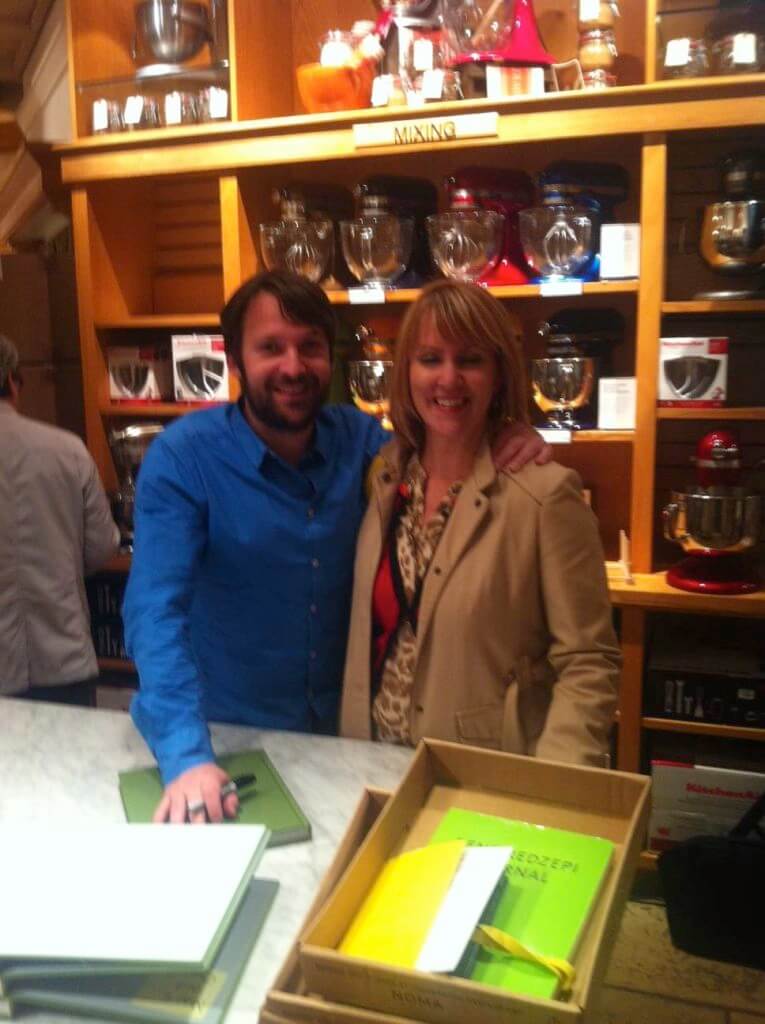Meeting Chef René Redzepi of Noma

Chef Redzipi, behind the World’s Best Restaurant, says, “Eat the place you’re in.”
When I got the invitation to meet Chef Rene Redzepi in LA I didn’t hesitate. After all, he helms the best restaurant in the world—Noma in Copenhagen, Denmark, which is famous for Nordic cuisine and sourcing indigenous foods. He was in town to do a book signing for his new book collection, A Work in Progress: Noma Recipes, Journal and Snapshots, which share his experiences at Noma. In fact, his arrival in LA was so celebrated, he had appeared on Jimmy Kimmel the night before I met him.
Boyish, charming, and totally unpretentious (he loves to liberally drop “f” bombs in polite conversation), Redzepi charmed the crowd at Williams Sonoma in Beverly Hills, where his book signing was hosted. Redzepi answered a few questions about his new book and journal, which captures the thinking process behind his imaginative food style. Redzepi learned at famous places, such as the French Laundry, and founded Noma in 2003—since then, the restaurant has taken the number one spot in the World’s 50 Best Restaurant Awards in 2010, 2011, and 2012. In 2008, Redzepi established the Nordic Food Lab, a non-profit institution established to explore Nordic cuisine. He also participates annually in MAD Food Camp, a platform that engages leading chefs, scientists, and academics each summer to discuss a new theme.
As Redzepi spoke about his culinary vision and process, you start realizing that his international team resembles an eclectic group of passionate, mad scientists working together in their lab, whiteboarding all of their extravagant hypothesis, before testing the creations with beakers and cooking utensils and appliances. He is famous for using unusual ingredients, from moss to tree branches, found in his local Scandinavian countryside. In fact, he hires “foragers” to scour the environs for his ingredients. Here are some excerpts from his talk:
It’s hard to stay on top, I’m only 32, there’s nowhere to go. My leads are from New York, Germany, and Mexico. The TexMex is awful in Denmark. But we were inspired with tortilla nixtamalization; we used this process with moss and it tastes like tortillas that taste a little like moss.
When I started in this field, it was hard work, and a bunch of alcoholic, criminals were the cooks. You go to cooking school to learn techniques, like making Béarnaise, but nobody tells you how to manage a restaurant, with different people and following up on 20,000 things a day. I hired someone to manage my restaurant. Our trade is becoming so civilized, it is going away from the blue collar trade, you can see this just by being here, it is changing.
I think of ingredients like a puzzle. For example, carrots. There is nothing better than fresh out of the soil carrots, once you cook them they’re not as good. I tried one month of carrots on everything we could possibly think of, and we found one carrot thing that was very new. If you keep going until you can’t think of it anymore, you will find something. There is no standard for when you’re done creating.
We do a lot of foraging at Noma for magnificent things. It connects you to the place instantly, you can eat the place you’re in. The ingredients range is exploding, there are so many flavors out there. You can know your landscape by learning how to cook these foods. It’s much more important than learning old school recipes. We have a full time forager to work with us. He now has seven employees. This is our first inspiration, when it comes into season. Once you see it, you can follow it, see the shoots, see how it works. When you take care of nature, if fills you with respect.
We are only 10 years old, I’m not ready to retire at 35. I am having more fun than ever.
Redzepi’s new cookbook is filled with mystical, magical foods that you will probably never cook —just take his Crispy Reindoor Moss, Cep Powder, and Crème Fraiche recipe, which looks more like the interior of a terrarium than an edible dish. His culinary style is more an inspiring exploration of the human spirit and the planet’s natural spring of resources, and how these are connected. As I thumb through the pages of his cookbook, I think that perhaps the ancient Vikings of this region once ate these wild foods for sustenance, and perhaps old cooks handed down some of these food traditions over the years. Yet other food traditions Redzepi has founded are completely unchartered, as if he’s challenging himself to see what else can be eaten, tasted, and experienced in his homeland. While some of America’s greatest chefs—Achatz and Keller—are certainly challenging themselves with the same thinking, I don’t think I’ve seen them take it as far as Redzepi. His culinary vision is the equivalent of me marching up to the wilderness behind my Los Angeles hills home and collecting every plant, insect, vine, tuber, growth and animal, and taking them back to my home kitchen to see what is edible, and what is not—and making it delicious and something worth with experiencing! The Gabrielinos (natives to this land) probably already beat me to this task, and did the testing long before I write this. Redzepi’s spirit of adventure is appreciated—as may be seen in his restaurant, which is piled up with awards—and I admire his respect for authenticity and place, which override stuffy food traditions from foreign lands. When you experience his food, you know that you can never be anywhere else but Noma in Denmark.
You can see a video of Chef Rene Redzepi on my YouTube Channel here
Featured Image: Sharon with Chef Rene Redzepi


